Red-eyed Tree Frog
- January 29, 2024
- 0 comment
The rainforests of Central America come alive with vibrant hues and captivating biodiversity, and among the enchanting creatures that inhabit this lush landscape is the Red-Eyed Tree Frog (Agalychnis callidryas).
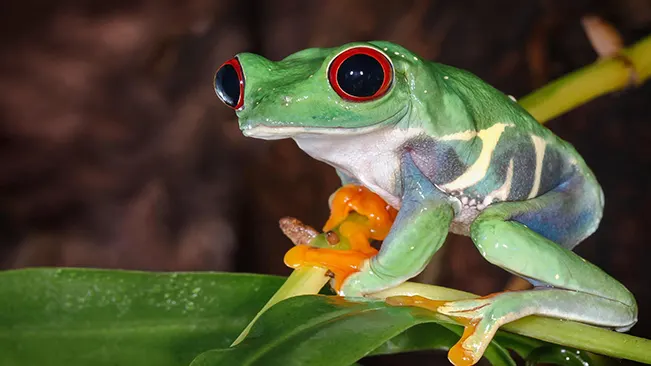
Renowned for its striking appearance and captivating behavior, this small amphibian has become an icon of tropical ecosystems. In this article, we will explore the fascinating world of the Red-Eyed Tree Frog, delving into its distinctive features, habitat, behavior, and the importance of its conservation.
| Category | Description |
|---|---|
| Physical Characteristics | |
| Size (Female) | Up to 3 inches |
| Size (Male) | Up to 2 inches |
| Weight | Less than 1 ounce |
| Color Variations | Green body with blue and white markings, red eyes with black pupils |
| Habitat Preferences | Rainforest canopy |
| Scientific Name | Agalychnis callidryas |
| Behavior | |
| Diet | Insects (crickets, flies, moths) |
| Mating Habits | Male clicks and flashes orange feet to attract mates |
| Communication Methods | Clicks, body language (throat inflation, color flashes) |
| Lifespan | 5-10 years (wild), up to 15 years (captivity) |
| Conservation Status | |
| Threats | Habitat loss (deforestation), climate change, chytrid fungus |
| Population Trends | Stable overall, localized declines |
| Protection Efforts | Habitat protection, awareness raising, research |
| Additional Notes | |
| Camouflage | Excellent camouflage due to green color and leaf-like patterns |
| Vision | Excellent night vision |
| Toxicity | Not poisonous, but flashes colors to warn predators |
Appearance
One cannot help but be mesmerized by the vivid and eye-catching appearance of the Red-Eyed Tree Frog. Sporting vibrant lime-green skin with bold blue and yellow stripes along its sides, this species is a true spectacle in the rainforest canopy.
Vibrant Lime-Green Skin
The body of the Red-Eyed Tree Frog is predominantly colored in a bright lime-green hue. This vibrant coloration serves multiple purposes, including camouflage in the lush green vegetation of its rainforest habitat.
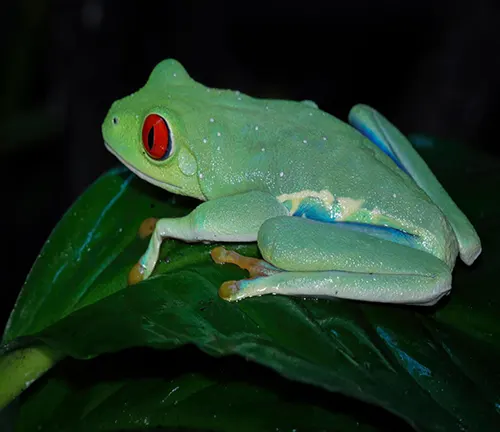

Bold Blue and Yellow Stripes
Along the sides of its body, the Red-Eyed Tree Frog sports bold blue and yellow stripes. These stripes enhance its overall visual appeal and contribute to its camouflage by resembling veins or leaf patterns.
Large, Bright Red Eyes
The most eye-catching feature of the Red-Eyed Tree Frog is its namesake – the large and intensely red eyes. These striking eyes are outlined with a thin, gold-colored ring. The bright coloration is believed to serve as a defense mechanism by startling potential predators when the frog opens its eyes suddenly, creating the illusion of a larger and more formidable creature.

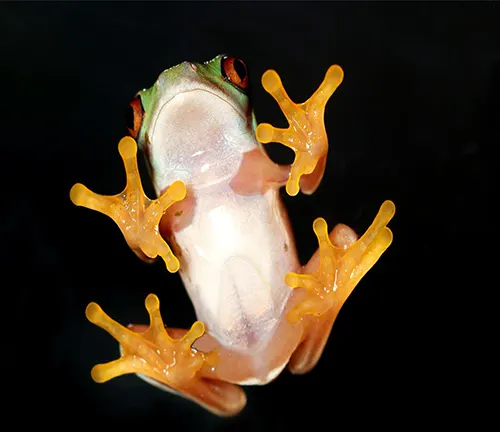
Webbed Feet with Orange Toe Pads
The frog’s toes are equipped with adhesive pads, allowing it to climb and adhere to various surfaces in its arboreal habitat. These toe pads are often orange or red, adding a splash of color to the underside of the frog’s limbs.
Slim Body and Long Legs
The Red-Eyed Tree Frog has a relatively slim body with long legs, which are adapted for climbing and jumping. These agile limbs help the frog navigate the branches and foliage of the rainforest canopy with ease.
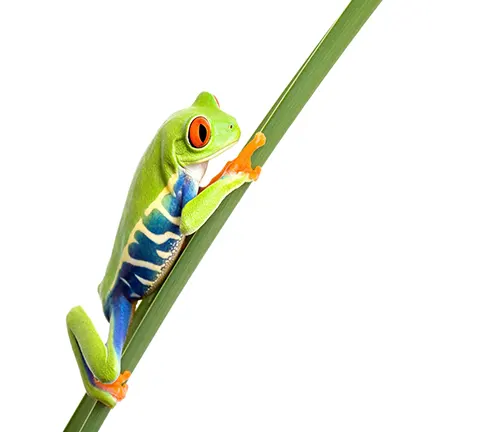
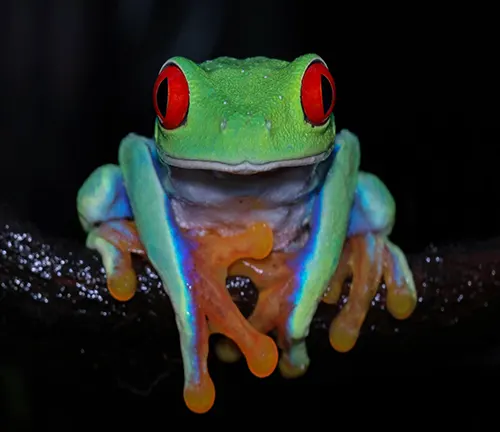
Nocturnal Pupils
While its vibrant red eyes are a prominent feature, the pupils of the Red-Eyed Tree Frog are vertical and slit-shaped, typical of many nocturnal species. This adaptation aids in low-light vision and enhances the frog’s ability to hunt for prey during the night.
Size
Red-Eyed Tree Frogs are considered relatively small, with adult individuals typically ranging from 2 to 3 inches (5 to 7.5 centimeters) in length.
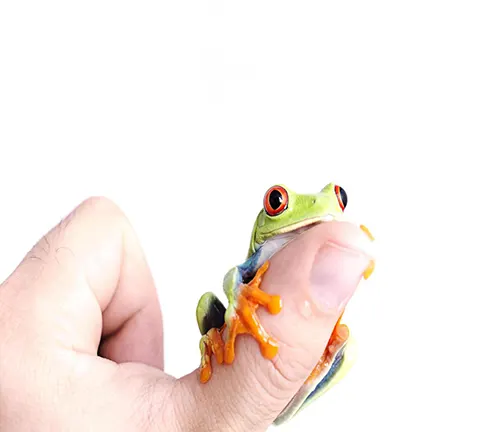
However, the most arresting feature is undoubtedly its large, bright red eyes, which provide a stark contrast to the rest of its colorful body. The purpose of these brilliant red eyes is not only to captivate observers but also to startle potential predators, creating the illusion of the frog being larger and more formidable.
Habitat
Red-Eyed Tree Frogs are primarily found in the tropical rainforests of Central America, including countries like Costa Rica, Nicaragua, Panama, and Honduras. These amphibians are well adapted to life in the treetops, spending the majority of their lives in the canopy.
Tropical Rainforests
Red-Eyed Tree Frogs are well-adapted to the humid and warm conditions of tropical rainforests. They are typically found in areas with high levels of rainfall and consistent temperatures throughout the year.
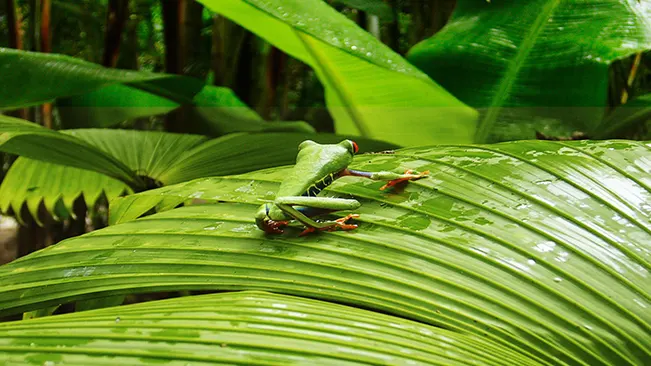
Canopy Dwellers
These frogs are arboreal, meaning they spend the majority of their lives in the treetops. They are often observed on the undersides of leaves, branches, and vegetation in the canopy. Their strong, adhesive toe pads allow them to cling to surfaces, making them proficient climbers.
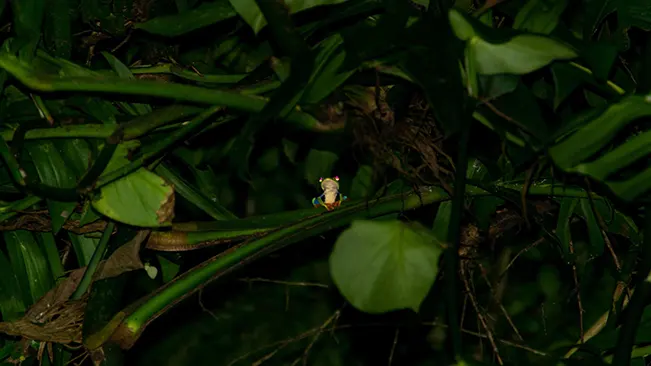
Vegetation and Foliage
The frogs seek refuge in the thick foliage of the rainforest during the day, using their cryptic coloration to blend seamlessly with their surroundings. This provides them with protection from predators and helps regulate their body temperature.
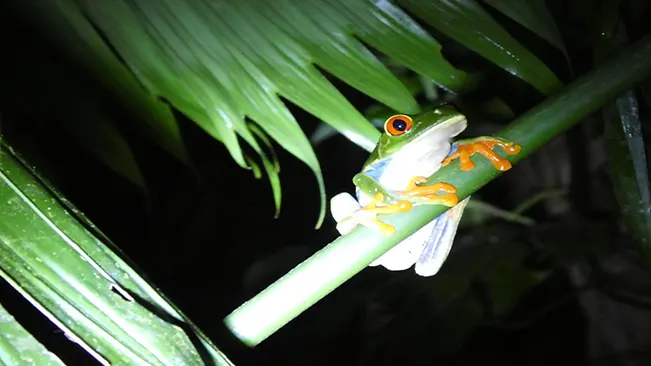
Proximity to Water
Red-Eyed Tree Frogs require water for breeding. While they spend most of their time in the trees, they typically lay their eggs on the undersides of leaves above water sources, such as ponds, streams, or other bodies of water. The tadpoles hatch and fall into the water, where they undergo the metamorphosis process.

Biodiversity Hotspots
These frogs are often found in biodiversity hotspots within the rainforest, where a variety of plant and animal species coexist. The rich diversity of flora and fauna provides ample food sources for the Red-Eyed Tree Frog, which primarily preys on insects.
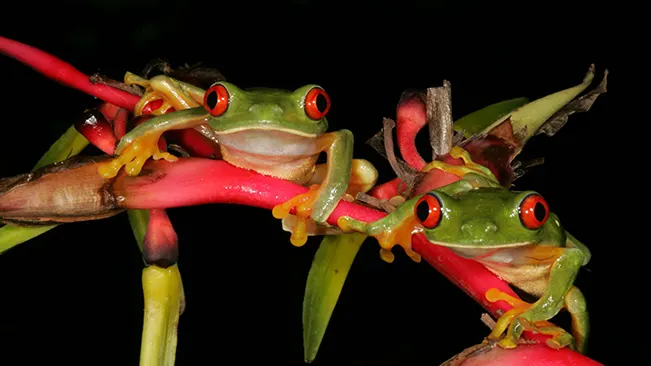
They are often observed perched on the undersides of leaves, using their excellent climbing abilities and strong, adhesive toe pads to navigate the branches with ease. The dense foliage provides them with both shelter and a wealth of insects, their primary source of food.
Behavior
The behavior of the Red-Eyed Tree Frog is as captivating as its appearance. Nocturnal by nature, these frogs are most active during the night, when they embark on hunting expeditions for small insects such as crickets and moths. Their powerful jumping abilities, combined with their exceptional vision, make them efficient predators. During the day, they seek refuge in the cool shade of the rainforest vegetation, blending seamlessly with their surroundings.
Nocturnal Lifestyle
Red-Eyed Tree Frogs are primarily nocturnal, meaning they are most active during the night. This behavior is likely an adaptation to avoid predators and take advantage of the cooler temperatures and increased insect activity in the dark.
Camouflage
During the day, these frogs utilize their remarkable camouflage abilities to blend seamlessly with the green vegetation in the rainforest canopy. They often rest on the undersides of leaves, where their vibrant coloration acts as disruptive camouflage, making them difficult to spot by potential predators.
Territorial Behavior
Male Red-Eyed Tree Frogs can exhibit territorial behavior, especially during the breeding season. They may establish and defend specific territories to attract females. Males are known for their distinctive vocalizations, producing a series of calls to attract potential mates and establish dominance over their territory.
Vocalizations
The vocalizations of the Red-Eyed Tree Frog play a crucial role in communication, particularly during the breeding season. Male frogs produce a unique and loud “chack” or “chuck” sound to attract females. The chorus of these calls creates a distinctive sound that resonates through the rainforest canopy.
Breeding and Parental Care
The breeding behavior of Red-Eyed Tree Frogs involves intricate rituals. Once a male attracts a female with his vocalizations, the pair engages in amplexus (mating position), and the female lays her eggs on the underside of leaves above water. The male then guards the eggs, ensuring their safety until they hatch. After hatching, tadpoles drop into the water below, where they continue their development.
Jumping and Climbing
Red-Eyed Tree Frogs are exceptional jumpers and climbers. Their strong, adhesive toe pads enable them to navigate the dense vegetation of the rainforest canopy with ease. This agility is essential for hunting prey, escaping predators, and finding suitable mates.
Diet and Hunting
As insectivores, Red-Eyed Tree Frogs primarily feed on a diet of crickets, moths, and other small insects. They use their excellent vision to locate prey, and their powerful hind legs allow them to make quick and precise jumps to catch their food.
Reproduction
The reproductive behavior of the Red-Eyed Tree Frog is equally intriguing. Males use their distinctive vocalizations to attract females, creating a chorus that echoes through the rainforest. Once a pair forms a connection, the female lays her eggs on the underside of leaves above water, and the male diligently guards them.
Courtship and Mating
Males attract females with distinctive vocalizations. Once a pair forms, the female lays eggs on the underside of leaves.

Egg Protection
The male guards the eggs until they hatch.
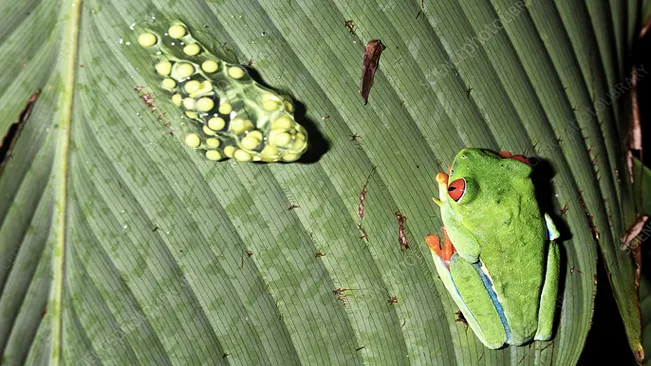
Tadpole Stage
Tadpoles drop into water after hatching. Undergo metamorphosis to transform into adult frogs.

After hatching, the tadpoles drop into the water, where they undergo metamorphosis before transitioning into their adult form.
Conservation
Despite their captivating presence, Red-Eyed Tree Frogs face numerous threats to their survival. Habitat destruction due to deforestation, pollution, and the pet trade are among the primary challenges. Conservation efforts are crucial to ensuring the long-term survival of these remarkable amphibians. Protected areas, sustainable forestry practices, and educational initiatives are essential components of safeguarding the Red-Eyed Tree Frog and its rainforest habitat.
Habitat Protection and Restoration
Preserving Rainforests: The primary threat to the Red-Eyed Tree Frog is habitat loss due to deforestation. Efforts must be made to protect and expand rainforest areas through the establishment and maintenance of protected reserves and national parks.
Restoration Initiatives: Restoration projects can help rehabilitate degraded habitats, providing additional breeding and feeding grounds for the frogs. Community involvement and sustainable land-use practices are essential components of these initiatives.
Sustainable Forestry Practices
Responsible Logging: Implementing sustainable forestry practices can minimize the impact of logging on the Red-Eyed Tree Frog’s habitat. Selective logging and reforestation efforts can help maintain the integrity of the ecosystem while meeting human needs.
Mitigating Pollution
Water Quality Management: The quality of water bodies in the frog’s habitat is vital for the survival of tadpoles. Measures should be taken to prevent pollution of rivers and ponds, which could negatively affect the amphibian’s reproductive success.
Combatting Climate Change
Mitigating Climate Impacts: Climate change poses a threat to many species, and the Red-Eyed Tree Frog is no exception. Efforts to reduce greenhouse gas emissions and adapt to changing climatic conditions are crucial for the long-term survival of these frogs.
Research and Monitoring
Population Studies: Regular monitoring of Red-Eyed Tree Frog populations provides valuable data for conservation efforts. Understanding population trends, distribution, and health is essential for targeted interventions.
Ecological Research: Further research into the frog’s ecological requirements, behavior, and interactions with other species can inform conservation strategies and help design effective protection measures.
Education and Awareness
Community Outreach: Engaging local communities in conservation efforts is essential. Education programs can raise awareness about the importance of the Red-Eyed Tree Frog in maintaining ecosystem balance and the potential economic benefits of ecotourism.
Illegal Pet Trade Awareness: Educating the public about the consequences of the illegal pet trade is vital. Efforts should be made to discourage the collection and trade of Red-Eyed Tree Frogs for the pet industry.
Legislation and Policy
Legal Protection: Establishing and enforcing laws to protect the Red-Eyed Tree Frog and its habitat is critical. This includes regulations against habitat destruction, illegal trade, and other activities that pose a threat to the species.
The Red-Eyed Tree Frog (Agalychnis callidryas) confronts significant threats to its existence, including habitat destruction from deforestation, pollution, and the pet trade. To secure the long-term survival of these captivating amphibians, essential conservation measures include establishing protected areas, adopting sustainable forestry practices, and implementing educational initiatives. These efforts collectively aim to safeguard the Red-Eyed Tree Frog and its vulnerable rainforest habitat.
Different Species of Red-Eye Tree Frog
Agalychnis annae (Blue-Sided Tree Frog) Found in Costa Rica and Panama, it closely resembles the Red-Eyed Tree Frog but has blue sides instead of the typical yellow or orange.
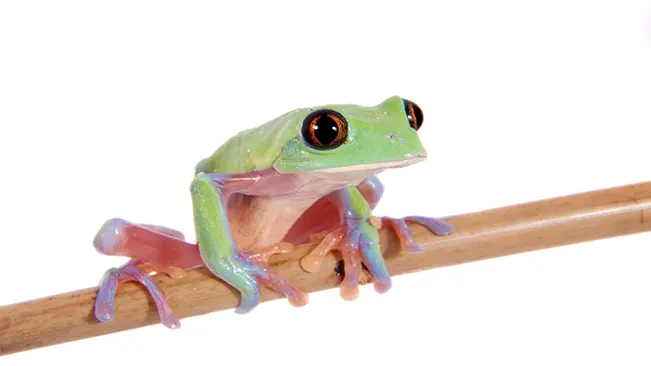
Agalychnis moreletii (Morelet’s Tree Frog) Native to Mexico, Belize, Guatemala, El Salvador, and Honduras, it has a bright green body with blue and yellow markings and distinctive red eyes.
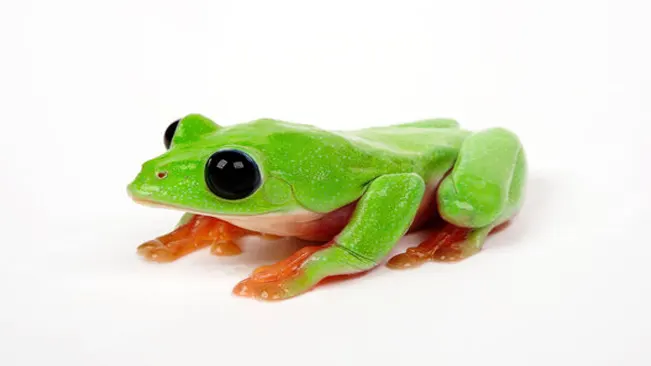
Agalychnis lemur (Lemur Leaf Frog) Endemic to Costa Rica and Panama, this species is critically endangered. It has large, expressive eyes and a greenish-yellow coloration.

Conclusion
The Red-Eyed Tree Frog, with its dazzling colors and fascinating behaviors, stands as a testament to the beauty and diversity of tropical ecosystems. As we marvel at this iconic amphibian, let us also reflect on the importance of conservation to preserve the delicate balance of the rainforest and ensure the continued existence of these enchanting creatures for generations to come.
Frequently Asked Questions (FAQs)
- Where is the natural habitat of the Red-Eyed Tree Frog?
The Red-Eyed Tree Frog is native to the rainforests of Central America, including countries like Costa Rica, Nicaragua, Panama, and Honduras. - What is the purpose of the red eyes of the Red-Eyed Tree Frog?
The bright red eyes serve as a startle defense mechanism to deter predators. They also contribute to the frog’s overall striking appearance. - How does the Red-Eyed Tree Frog protect its eggs?
The male guards the eggs laid on the underside of leaves until they hatch, ensuring their safety from potential threats. - Is the Red-Eyed Tree Frog primarily nocturnal or diurnal?
The Red-Eyed Tree Frog is primarily nocturnal, being most active during the night for hunting and mating. - What is the diet of the Red-Eyed Tree Frog?
Their diet consists mainly of small insects such as crickets, moths, and other arthropods. - How do Red-Eyed Tree Frogs move in their habitat?
They are excellent climbers and use their strong, adhesive toe pads to navigate the branches in the rainforest canopy. - How long does the tadpole stage of the Red-Eyed Tree Frog last?
The tadpole stage typically lasts several weeks before the metamorphosis into adult frogs. - Are Red-Eyed Tree Frogs endangered?
While they are not currently classified as endangered, they face threats due to habitat loss, pollution, and the pet trade, necessitating conservation efforts. - Do Red-Eyed Tree Frogs have any predators?
Predators can include snakes, birds, and certain mammals. The frogs employ their vibrant coloration and eye display to deter potential threats. - How do Red-Eyed Tree Frogs communicate with each other?
Males use distinctive vocalizations to attract females during the mating season, creating a chorus in the rainforest.


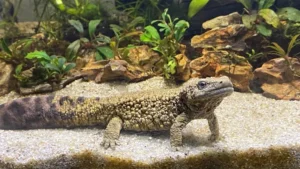
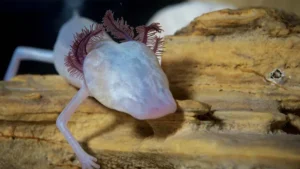

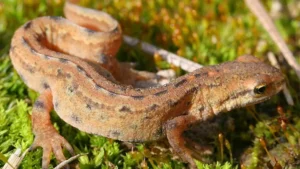
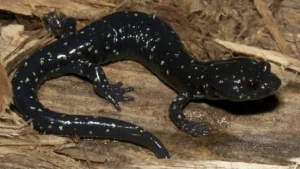
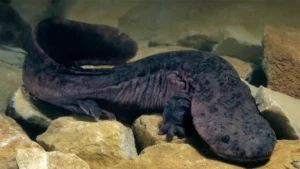

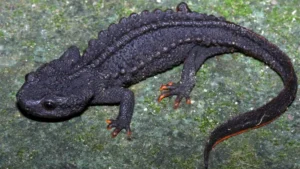
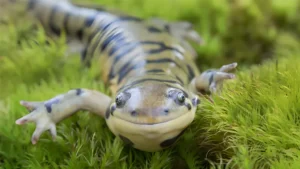



Leave your comment